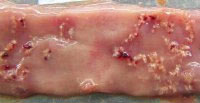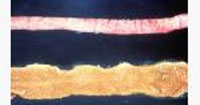



Tackling Necrotic Enteritis with Orego-Stim
The challenge of necrotic enteritis and its solution with Orego-Stim are covered in Technical Bulletin No. 10 from Meriden Animal Health.Introduction
 |
 |
 |
Necrotic enteritis is one of the most common and financially devastating bacterial diseases in modern poultry production. It has been reported in most poultry producing countries all over the world. The disease is caused by Clostridium perfringens, a gram-positive, anaerobic bacterium that can be found in soil, dust, litter, feed, faeces and at low levels in the intestines of healthy birds. It causes significant mortality in broilers during the rapid growth phase. The damage to the intestinal lining causes diarrhoea, which eventually leads to malabsorption and an adverse effect on broiler performance.
Necrotic enteritis is an enterotoxaemic disease that most often occurs either following an alteration in the intestinal microflora or from a condition that results in damage to the intestinal mucosa, such as that due to coccidiosis, salmonellosis and mycotoxicosis.
Clinical Signs
There are five types of C. perfringens (A, B, C, D and E), which produce a number of toxins – α, β, ε, ι and CPE. However, the two primary types that are associated to necrotic enteritis in poultry are types A and C. The α-toxin is an enzyme, which is believed to be the key to the occurrence of necrotic enteritis, as it causes necrosis of the tips of the intestinal lining. Characteristically, the intestinal lining develops a crusty, velvet-like appearance due to the presence of coagulating necrotic material. The fibrino-necrotic enteritis that develops causes the intestines of infected birds to be friable, distended with gas and contains a foul-smelling brown liquid. Various regions of the gut can be affected.
 |
 |
 |
 |
In the acute form of necrotic enteritis, birds often die without clinical signs. However, in its sub-clinical form, the disease is much more financially damaging for the producer. The birds huddle together, have ruffled feathers, appear depressed and may stop eating. The commonly observed symptoms of the disease vary with the age of the birds. Early signs of a necrotic enteritis outbreak are often wet litter and diarrhoea, even though at this stage, an increase in mortality is not so obvious. However, the depression of growth rate and feed efficiency of birds become noticeable by day 35 because of damage to the intestine and a subsequent reduction in digestion and absorption of feed. Furthermore, increased condemnations may occur at processing due to liver lesions associated to subclinical necrotic enteritis.
If an infected flock is not treated, the disease can last up to 12 days. Outbreaks can occur as early as seven days of age, but mostly occur at day 17 to 18. Mortality may be as high as 50 per cent but diarrhoea may not necessarily be seen in milder cases. Growth rates may be severely depressed and uniformity badly affected. These effects can be experienced in the absence of significant mortality. Necrotic enteritis has also been associated with increased feed conversion ratios.
Trigger Factors
In healthy chickens, C. perfringens normally live harmlessly in the lower gut, and are found in the caeca and lower large intestines. The pH and high oxygen content of a healthy small intestine does not support growth of the organisms. So for necrotic enteritis to occur there needs to be a trigger factor that tips the balance in favour of the bacteria, allowing them to proliferate and migrate to the upper intestines.
Several health and husbandry factors can contribute to an outbreak of necrotic enteritis. For example, direct damage to the intestinal mucosa caused by mycotoxins, salmonellosis, a coccidial infection or a change in the normal intestinal microflora as a result of a change in diet or physiological stress can predispose birds to the rapid proliferation of C. perfringens. Other physical factors that predispose birds to the disease by damaging the gut lining are lack of grit, changes in physical feed presentation and litter impaction in the intestines. Feed may also be contaminated with clostridial spores, which are highly resistant to destruction by desiccation, chemicals or extremes of temperature.
High dietary levels of wheat, barley, oats, rye, rapeseed or animal byproducts such as fishmeal may also predispose the birds to an infection. Changes in feed and nutrient density, such as protein levels may all be factors which also trigger the disease.
Stressful periods may also reduce resistance to intestinal infections. Immunosuppressive agents such as the chicken anaemia virus, infectious bursal disease virus or Marek's disease virus all weaken the immune system of the birds and promote excessive bacterial growth and toxin production, which then slows down the passage of feed and may then promote the occurrence of necrotic enteritis.
Prevention, Control and Treatment
Outbreaks of necrotic enteritis have usually been prevented by the inclusion of antibiotics such as penicillin derivatives, zinc bacitracin, lincomycin and avilamycin in the feed. In the European Union, where antibiotic growth promoters have been banned from the feed, ionophore anticoccidials such as monensin, salinomycin, maduramycin, narasin and lasalocid have been used to prevent and manage necrotic enteritis, as effective control of coccidiosis has been known to be the single most important aspect of prevention, which is able to greatly reduce the risk of necrotic enteritis. The addition of these anticoccidial compounds, especially those of the ionophore class, has been extremely helpful in preventing the coccidial damage that leads to necrotic enteritis.
However, resistance to tetracyclines or the macrolide-lincosamide antibiotics have been reported in various countries around the world, and there now exists a great pressure in many markets to eliminate the usage of other antibiotics and anticoccidials as well, because of a perceived risk to their efficacy when used as a treatment.
How Orego-Stim® Controls and Prevents Necrotic Enteritis
Orego-Stim is a natural, phytogenic feed additive and continues to be the market leader amongst all other essential oils in the livestock industry. Extensive in vitro and in vivo trials have proven that Orego-Stim assists in alleviating problems associated with the presence of C. perfringens and other gastrointestinal pathogens such as E. coli, Salmonella spp. and Eimeria spp. The essential oil within Orego-Stim consists predominantly of a unique ratio and concentration of the natural phenolic compounds carvacrol and thymol, which are known to be powerful antimicrobial agents. Phenols kill bacteria such as C. perfringens through its toxic effect on the cell wall, by denaturing and coagulating the proteins within the cell wall structure. The increase in permeability causes leakage of cellular constituents, resulting in water imbalance and cell death.
Orego-Stim has also been proven to contain anticoccidial properties. In the normal intestinal mucosa, the epithelial lining is regularly shed, and replacement occurs by cell division from within the crypts. Phenols act on the gut lining by increasing the rate of enterocyte turnover by about two times the normal rate. The phenolic compounds in Orego-Stim disrupt the life cycle of coccidian parasites by speeding up the rate of shedding of the gut lining. Through this mode of action, intracellular coccidial sporozoites are shed before they have the opportunity to penetrate deeper into the gut wall or form new oocysts. Clinical coccidiosis is therefore prevented or controlled by creating an environment that is hostile to the life cycle of the parasite. The absence of a coccidial challenge greatly reduces the risk of a necrotic enteritis outbreak and opportunistic infection by other secondary bacterial invaders.
Because C. perfringens is nearly ubiquitous, it is important to prevent changes in the intestinal microflora that could promote its growth. It is known that beneficial and pathogenic bacteria coexist in the gastrointestinal tract in an inverse relationship that is governed by competitive exclusion. When the animal undergoes a period of stress or disease challenge, the population of beneficial bacteria drops, allowing the numbers of C. perfringens to increase to a threshold that upsets the microbial balance and cause the disease.
Based upon results of antimicrobial sensitivity tests, Orego-Stim has a higher killing affinity towards first the Clostridium and Salmonella group, followed by E. coli, then the Streptococcus, Staphylococcus and Enterococcus groups, and lastly other bacteria, including beneficial microbes such as Bifidobacterium and Lactobacillus. So even if Orego-Stim selectively kills what may seem like only a small percentage of pathogenic bacteria in comparison to beneficial bacteria, it actually represents a large percentage of pathogen reduction and this improves the gut microbial flora by ensuring that pathogen numbers are kept to a check and the reestablishment of beneficial bacteria within the gut takes place via competitive exclusion. Continuous use of Orego-Stim will thus ensure that the numbers of pathogens are kept at the lowest possible levels, while maintaining and preserving healthy levels of beneficial bacteria populations in the intestines.
In contrast to antibiotic growth promoters and coccidiostats, there has been no evidence of development of bacterial resistance from using Orego-Stim simply because its inhibitory effect on bacteria is due to its phenolic mode of action, which is by direct contact. Orego-Stim is also not absorbed through the intestines into the bloodstream; hence there are no residues in livestock products such as meat or eggs. This means that no withdrawal period is necessary and Orego-Stim can be used right up to the slaughter period.
Summary
Necrotic enteritis is a complex, multi-factorial disease with many unknown factors influencing its occurrence and the severity of outbreaks. In particular, sporadic outbreaks of necrotic enteritis can occur frequently in farms where antibiotics are not used as growth promoters or coccidial infections are not controlled, and also where husbandry practice is not strict.
Due to its mode of action and its ability to inhibit the lifecycle of coccidiosis, the use of Orego-Stim has proven to be a natural, safe, economic and practical solution to the control and prevention of necrotic enteritis in poultry production. Its use in fighting the disease goes hand-in-hand with global efforts to reduce the industry’s reliance upon antibiotic growth promoters and coccidiostats.
Further Reading
| - | Find out more information on necrotic enteritis by clicking here. |
July 2011








